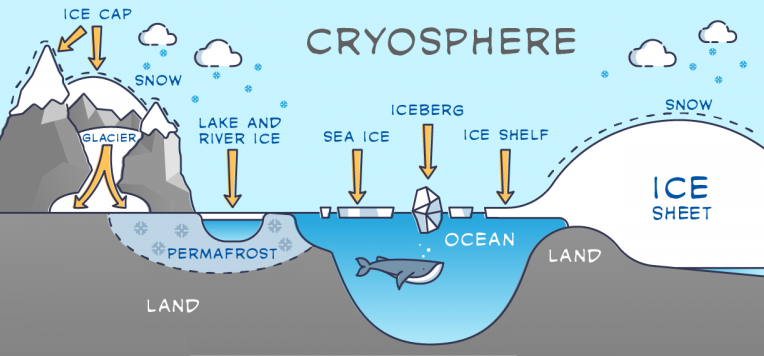- Home
- Prelims
- Mains
- Current Affairs
- Study Materials
- Test Series
What is the cryosphere?. Why is this important?. How does it affect our life on planet Earth?.
Cryosphere
- The cryosphere is the part of theEarth’s climate system that includes solid precipitation, snow, sea ice, lake and river ice, icebergs, glaciers and ice caps, ice sheets, ice shelves, permafrost, and seasonally frozen ground.
- The term “cryosphere” traces its origins to the Greek word ‘kryos’ for frost or ice cold.
- The cryosphere extends globally, existing seasonally or perennially at most latitudes, not just in theArctic, Antarctic, and mountain regions, and in approximately one hundred countries.
- The largest continental ice sheets are found in Antarctica.
- Approximately70% of the Earth’s freshwater exists as snow or ice.

Significance of Cryosphere
- The components of the cryosphere play an important role in the Earth’s climate. Snow and ice reflect heat from the sun, helping to regulate our planet’s temperature. Because polar regions are some of the most sensitive to climate shifts, the cryosphere may be one of the first places where scientists are able to identify global changes in climate.
- Naturally, in the winter months, regardless of it we live in the Northern or Southern Hemisphere, we can expect to see an increase of colder weather and more snow and ice. And while some people may not like snowy winter days and freezing temperatures, this aspect of the cryosphere is essential to cooling down the Earth.
- Not only does the cryosphere help to control the planet’s temperature, but it also controls the global sea levels. It affects ocean currents and storm patterns around the world, and the melting snow and ice provides freshwater for human consumption and irrigation of our crops.
- Changes in the ocean and cryosphere occur naturally, but the speed, magnitude, and pervasiveness of the global changes happening right now have not been observed for millennia or longer. Evidence shows that the majority of ocean and cryosphere changes observed in the past few decades are the result of human influences on Earth’s climate.
Impact on Global Climate
-
- Albedo:
- Snow and ice have high albedo. They reflect most of the light without being absorbed and helps in cooling of the earth. Thus, presence or absence of snow and ice affects theheating and cooling of Earth’s surface.
- This influences theentire planet’s energy balance.
- Feedback Loop:
- Melting of icereduces the reflective surface, and, the ocean and land are darker in color, which absorb more solar radiation, and then release the heat to the atmosphere.
- This causes more warming and so more ice melts.This is known as a feedback loop.
- Permafrost:
- Permafrost is potentially a major source ofmethane and carbon dioxide.
- Thepermafrost of the polar region has trapped tons of carbon inside its soil.
- If ‘feedback loop’ aggravates, the carbon is releasedin form of methane- a powerful greenhouse gas- which causes the global warming.
- Permafrost contains about 1,400 to 1,600 billion tons of carbon.
- In terms ofcarbon budgets, in the 1.5°C climate warming scenario, the melting of permafrost is estimated to result in a range of 150–200 Gt CO2-eq emissions, while at 2+°C degrees would result in at about 220–300 Gt CO2-eq by 2100, comparable to the total emissions of countries like Canada or the entire EU.
- Melting of Cryosphere:
- Melting of cryosphere affects the volume of water in oceans. Any changes in the water cycle, affects global energy / heat budget, and thereby global climate.
- The emission of GHGs and changes in albedo from a melting Arctic are projected to more than double the Arctic’s contribution to global warming by 2100.
- Melting of cryosphere affects the volume of water in oceans. Any changes in the water cycle, affects global energy / heat budget, and thereby global climate.
- Albedo:









 Latest News
Latest News
 General Studies
General Studies